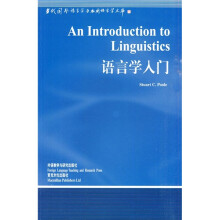语言学入门(新)
作者:(英)普尔 著
出版:外语教学与研究出版社 2000.6
丛书:当代国外语言学与应用语言学文库
页数:218
定价:29.90 元
ISBN-10:7560018696
ISBN-13:9787560018690
去豆瓣看看 Preface
Preface by Halliday
王宗炎序
导读
1 What Is language
1.1 The Sinmificance of Language
1.2 What Is Language
1.3 The Functions of language
1.4 What Is a language
1.5 The Elements of language
Summary
Exercises
2 Lexis
2.1 What Is a Word
2.2 Where Do Words Come From
Summary
Exercises
3 Sexia
3.1 The Function of lexemes
3.2 The meaning of meaning
3.3 Semantic Range
3.4 The Definition of Semantic Range
3.5 Collocation and Idiom
3.6 Homonyny and Idiom
3.7 The Human Element of Meaning
3.8 Pragmatics
3.9 Pragmatics
Summary
Exercises
4 Phonetics
4.1 The Organs of Speech
4.2 Comsonants
4.3 Phonemic Notation
4.4 Vowels
4.5 Sounds in Sequence
Summary
Exercises
5 Phonology
5.1 Sound Sydtens of Lanuages
5.2 The Phoneme
5.3 Phoniological Rules
5.4 The Phonology of English
5.5 The Phonoloty of Other languages
5.6 Supraesgmental Features
Summary
Exercises
6 Morphology
6.1 The Composition of Words
6.2 Morphemes
6.3 Derivation and Inflection
6.4 Productivity and Word Formation
6.5 Problems of Morphological Analysis
Summary
Exercises
7 Syntax
7.1 Syntax as Opposed to Morphology
7.2 Word Classes
7.3 Constituent Structure
7.4 Noam Chomsky
7.5 Syntactic Forms
Summary
Exercises
8 Regional Variation
8.1 Variations of Variations
8.2 Horizontal Definition of Dialect
8.3 Vertical Definition of Dialect
8.4 The Nature of Variation
Summary
Exercises
9 Social Variation
9.1 The Social Dimension
9.2 111e Standard Language
9.3 The Urban Vanguard
9.4 Men and Women
9.5 Power and Solidarity
9.6 Registers and Diglossia
9.7 Taboo and Political Correctness
9.8 Slang
Summary
Exercises
10 Historical Linguistics
10.1 111e Diachronic Dimension
10.2 How Language Changes
10.3 Why Language Changes
10.4 When Language Changes
10.5 Divergence
10.6 Convergence
10.7 Pidgins and Creoles
Summary
Exercises
11 The Languages of Western Europe
11.1 The Indo-European Family of Languages
11.2 The Germanic Languages
11.3 The Romance Languages
11.4 The Celtic Languages
11.5 Finnish
Summary
Texts
Exercises
12 Writing Systems
12.1 Communication across Time and Space
12.2 Morphemic and Phonetic Script
12.3 Chinese Script-A Morphemic System
12.4 Roman Script-An Alphabetic System
12.5 Allographs
Summary
Exercises
Glossary
Guide to Exercises
Bibliography
Indes
文库索
Stuart C.Poole is Co-ordinator of the Language Programme at the Centre for Continuing Education,University of Edinburgh.He teaches linguistics and Swedish and has published a textbook on the Catalan language.He is a Fellow of the Institute of Linguists and served for some years as chairman of its Scottish Society.
《语言学入门(新版)》以通俗的英语向读者介绍了当代语言学所涉及的诸多领域和学科,包括语言的定义、词汇学、语义学、音位学、句法学、文体学等。This book introduces the nature of language. It deals with the sounds that we make when we speak, with the way in which we construct sentences, with the ways in which our speech varies between social situations, and so no. It does so by the commonly adopted method of having chapters with such headings as phonetics, syntax, social variation. Less conventionally, it has a major chapter which, againse the background of these aspects of linguistics, presents the principal features of the languages of western Europe. You have at least one remarkable skill; you can speak a language. For at least one language you generally know what can and what cannot be designated by the everyday words, you know what is and what is not an acceptable way of combining words to form a sentence, you have a good idea of whether or not a particular statement would be acceptable in a particular social situation. As a skilled user, then, you already have a substantial foundation for the study of language. That foundation and an interest in language are all you need; given those, this introductory book can lead you to an understanding of what language consists of ,of how it works. It serves as an introductory book for students of linguistics and as important background material for students of modern languages. Reflecting my work in continuing education, I have attempted to write in a readable style that will also made the book attractive to the many people who want to explore the fascinating world of language without entering full-time education. I would like to thank my wife Bery1 and a student, Arthur McIvor, for taking time to read and comment on my draft. I also thank Bery1 for her support and tolerance while I was working on the book. I also thank Arthur as a representative of those students whose interest and enthusiansm help to inspire and reward my work. The facilties of the University of Edinburgh such as the library and word-processing facilities have been of great assistance.

 缺书网
缺书网 扫码进群
扫码进群







